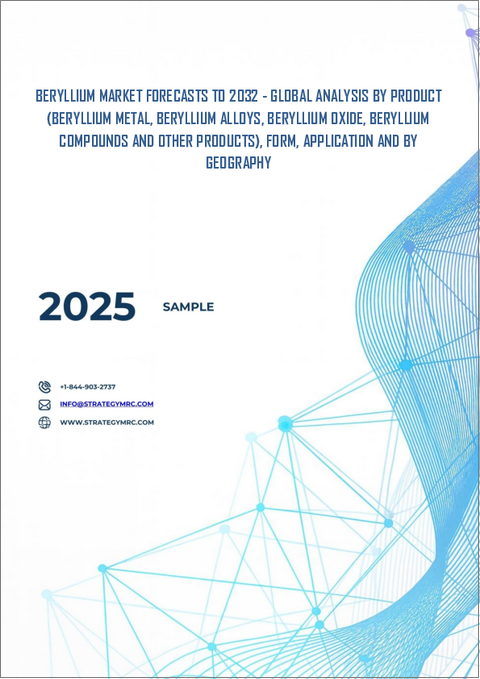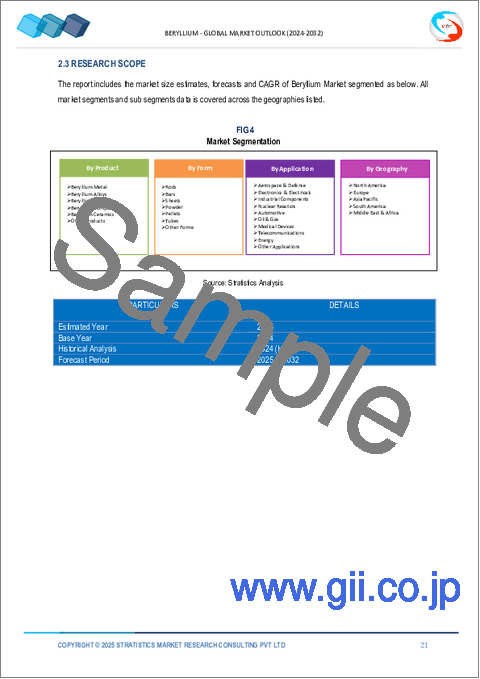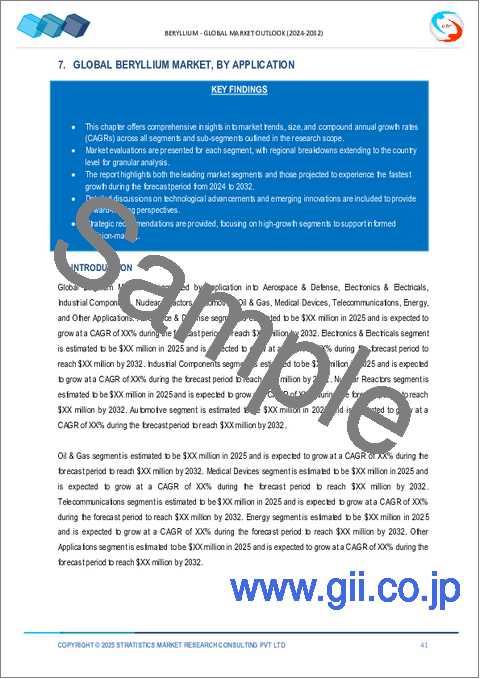|
|
市場調査レポート
商品コード
1725078
ベリリウム市場の2032年までの予測:製品別、形態別、用途別、地域別の世界分析Beryllium Market Forecasts to 2032 - Global Analysis By Product (Beryllium Metal, Beryllium Alloys, Beryllium Oxide, Beryllium Compounds and Other Products), Form, Application and By Geography |
||||||
カスタマイズ可能
|
|||||||
| ベリリウム市場の2032年までの予測:製品別、形態別、用途別、地域別の世界分析 |
|
出版日: 2025年05月03日
発行: Stratistics Market Research Consulting
ページ情報: 英文 200+ Pages
納期: 2~3営業日
|
全表示
- 概要
- 図表
- 目次
Stratistics MRCによると、世界のベリリウム市場は2025年に73億4,000万米ドルを占め、2032年までにはCAGR8.6%で成長し、130億9,000万米ドルに達すると予測されています。
ベリリウムは原子番号4の金属元素で、硬くて脆く、軽量です。アルカリ土類金属グループに属し、鋼鉄のような灰色をしています。非磁性で耐食性に優れ、融点が高く、熱伝導率が非常に高いです。剛性と寸法安定性が高いため、主に原子力、IT・通信、航空宇宙産業で利用されています。その価値にもかかわらず、ベリリウムは粉塵やガスとして摂取すると危険であるため、取り扱いには注意が必要です。バートランダイトやベリルのような鉱物は、自然にそれを含んでいます。
日本電子情報技術産業協会(JEITA)によると、世界の電子情報技術産業は2024年に9%成長し、3兆6,868億米ドルに達すると予測されています。
エレクトロニクスと通信の成長
ベリリウムは、その優れた電気絶縁性と熱伝導性により、高性能電子部品に最適です。その堅牢性と携帯性は、通信機器に使用されるスイッチ、リレー、コネクターの製造に不可欠です。ベリリウムを含む材料へのニーズは、5Gインフラ、データセンター、スマートフォンへのニーズの高まりによって高まっています。ベリリウム合金は、高度な防衛・航空宇宙通信システムにも不可欠です。ベリリウムの市場拡大は、世界がデジタルへの移行を続ける中で、デバイスの効率性と耐久性を保証する役割を担っていることが原動力となっています。
代替品の入手可能性
電子機器や航空宇宙分野では、複合材料、チタン、アルミニウムのような材料が同等の目的を果たすことができるため、ベリリウムの必要性が低下します。これらの材料は安価であることが多いため、コスト削減を目指す企業にとっては、代替品の方が望ましいです。さらに、ベリリウムは不適切に扱われると有害であることが知られているため、代用品は優れた環境・安全プロファイルを提供できる可能性があります。新しい用途でのベリリウムの使用は、このような代替品への傾向の高まりによって大幅に減速しています。このため、ベリリウム市場は、他の材料に押されて市場シェアを維持することが困難になっています。
エレクトロニクスの進歩
ベリリウムの需要は、その卓越した強度対重量比と熱伝導性により、エレクトロニクスの進歩に大きく後押しされています。性能と信頼性を保証するベリリウムのような材料は、電子機器の小型化と高性能化に伴い、ますます必要性が高まっています。ベリリウムは、半導体デバイス、スイッチ、高性能コネクターに不可欠です。防衛および航空宇宙用電子機器への応用は、市場の拡大をさらに推進します。ベリリウムベースの部品に対するニーズは、5G技術や電気自動車の開発によっても促進されています。あらゆることを考慮すると、世界のベリリウム市場の規模と価値は、エレクトロニクスの進歩によって直接的に増大します。
製品セグメンテーション
カスタマイズされたソリューションが要求されるため、生産コストが上昇することが多いです。複数の製品ラインを管理することは困難で、リソースに負担をかけ、経営効率を低下させる。さらに、セグメンテーションがもたらす市場の細分化によって、規模の経済を達成することが困難になる可能性もあります。加えて、メーカーが新しいアプリケーションを生み出すよりも既存のセグメントを優先する可能性があるため、焦点を絞った製品では技術革新の可能性が制限される可能性があります。その結果、市場全体の成長と業界のイノベーションが鈍化する可能性があります。
COVID-19の影響
COVID-19の大流行はベリリウム市場に大きな影響を与え、サプライチェーン、製造プロセス、世界貿易に混乱をもたらしました。操業停止や制限により、航空宇宙、電子機器、エネルギーなどの主要産業の需要が減少しました。しかし、産業が操業を再開するにつれて、市場は徐々に回復しました。パンデミック(世界的大流行)の間、ヘルスケア技術とエレクトロニクスへの注目度が高まったことが需要の転換につながり、医療機器や先端エレクトロニクスのような特殊用途におけるベリリウムの長期的成長見通しを支えています。
金属ベリリウム・セグメントが予測期間中最大となる見込み
ベリリウム金属セグメントは、軽量、高強度、優れた熱伝導性といった独自の特性により、予測期間中最大の市場シェアを占めると予想されます。これらの特質により、電子機器、航空機、防衛など、高性能材料が重要な分野での応用に最適です。金属ベリリウムへの要求は、さまざまなハイテク用途で強靭で軽量な部品へのニーズが高まっているため、さらに高まっています。特に通信や電気自動車のような分野での技術進歩の高まりは、このカテゴリーにとって有利です。さらに、ベリリウムは最先端材料の性能を向上させる能力があるため、その受容が加速し、市場の成長を後押ししています。
予測期間中、石油・ガス分野のCAGRが最も高くなると予想されます。
予測期間中、石油・ガス分野は特殊材料への需要により、最も高い成長率を示すと予測されます。ベリリウム合金は、掘削機械や装置において強度と耐久性を向上させる。この材料は高温・高圧に耐えるため、石油・ガス採掘の高性能部品に最適です。ベリリウムの軽量特性は燃費を向上させ、機器の摩耗を軽減するため、需要はさらに増加します。ベリリウムベースの製品に対する需要は、特に深海探査と海洋掘削の分野の成長に伴って増加すると予想されます。
最大のシェアを持つ地域:
予測期間中、アジア太平洋は、防衛産業や通信産業における需要の増加により、最大の市場シェアを占めると予想されます。中国、日本、韓国のような国々は、先進的な製造部門を擁するため、主要な消費国となっています。ベリリウムの軽量・高強度特性は、衛星、防衛機器、高速コンピューティング・システムの精密部品に理想的です。防衛と技術革新への投資の増加は、この地域の消費をさらに押し上げます。加えて、特に中国における地元の採掘・精製能力が供給の安定性を支え、世界の輸入品への依存度を下げています。
CAGRが最も高い地域:
予測期間中、北米地域が最も高いCAGRを示すと予想されるが、これは航空宇宙産業とエレクトロニクス産業での使用が不可欠であるためです。衛星システム、医療機器、通信などの用途における高性能材料の需要が、この市場を牽引しています。北米の強力な産業基盤は、再生可能エネルギーや自動車などの分野における技術進歩と相まって、市場拡大をさらに後押ししています。さらに、同地域の主要企業は持続可能な採掘方法とベリリウム抽出技術の向上に注力しています。米国は、世界最大のベリリウム生産国および消費国であり、大きな市場シェアを占めています。
無料のカスタマイズサービス:
本レポートをご購読のお客様には、以下の無料カスタマイズオプションのいずれかをご利用いただけます:
- 企業プロファイル
- 追加市場企業の包括的プロファイリング(3社まで)
- 主要企業のSWOT分析(3社まで)
- 地域セグメンテーション
- 顧客の関心に応じた主要国の市場推計・予測・CAGR(注:フィージビリティチェックによる)
- 競合ベンチマーキング
- 製品ポートフォリオ、地理的プレゼンス、戦略的提携に基づく主要企業のベンチマーキング
目次
第1章 エグゼクティブサマリー
第2章 序文
- 概要
- ステークホルダー
- 調査範囲
- 調査手法
- データマイニング
- データ分析
- データ検証
- 調査アプローチ
- 調査資料
- 1次調査資料
- 2次調査情報源
- 前提条件
第3章 市場動向分析
- 促進要因
- 抑制要因
- 機会
- 脅威
- 製品分析
- 用途分析
- 新興市場
- COVID-19の影響
第4章 ポーターのファイブフォース分析
- 供給企業の交渉力
- 買い手の交渉力
- 代替品の脅威
- 新規参入業者の脅威
- 競争企業間の敵対関係
第5章 世界のベリリウム市場:製品別
- ベリリウム金属
- ベリリウム合金
- 酸化ベリリウム
- ベリリウム化合物
- ベリリウムセラミックス
- その他の製品
第6章 世界のベリリウム市場:形態別
- ロッド
- バー
- シート
- 粉末
- ペレット
- チューブ
- その他の形態
第7章 世界のベリリウム市場:用途別
- 航空宇宙および防衛
- 電子機器と電気機器
- 産業用部品
- 原子炉
- 自動車
- 石油・ガス
- 医療機器
- 通信
- エネルギー
- その他の用途
第8章 世界のベリリウム市場:地域別
- 北米
- 米国
- カナダ
- メキシコ
- 欧州
- ドイツ
- 英国
- イタリア
- フランス
- スペイン
- その他の欧州
- アジア太平洋
- 日本
- 中国
- インド
- オーストラリア
- ニュージーランド
- 韓国
- その他のアジア太平洋
- 南米
- アルゼンチン
- ブラジル
- チリ
- その他の南米
- 中東・アフリカ
- サウジアラビア
- アラブ首長国連邦
- カタール
- 南アフリカ
- その他の中東・アフリカ
第9章 主な発展
- 契約、パートナーシップ、コラボレーション、ジョイントベンチャー
- 買収と合併
- 新製品発売
- 事業拡大
- その他の主要戦略
第10章 企業プロファイリング
- Materion Corporation
- Ulba Metallurgical Plant
- IBC Advanced Alloys Corp.
- NGK Metals Corporation
- Hunan Shuikoushan Nonferrous Metals Group Co., Ltd.
- Xinjiang Xinxin Mining Industry Co., Ltd.
- American Beryllia Inc.
- Belmont Metals, Inc.
- American Elements
- Texas Mineral Resources Corp.
- Tropag Oscar H. Ritter Nachf GmbH
- Xiamen Beryllium Copper Technologies Co., Ltd.
- Beryllium & Aluminum Alloys, LLC
- Toho Titanium Co., Ltd.
- Solvay SA
- Ametek, Inc.
- The Beryllium Group
- Bechtel Corporation
List of Tables
- Table 1 Global Beryllium Market Outlook, By Region (2024-2032) ($MN)
- Table 2 Global Beryllium Market Outlook, By Product (2024-2032) ($MN)
- Table 3 Global Beryllium Market Outlook, By Beryllium Metal (2024-2032) ($MN)
- Table 4 Global Beryllium Market Outlook, By Beryllium Alloys (2024-2032) ($MN)
- Table 5 Global Beryllium Market Outlook, By Beryllium Oxide (2024-2032) ($MN)
- Table 6 Global Beryllium Market Outlook, By Beryllium Compounds (2024-2032) ($MN)
- Table 7 Global Beryllium Market Outlook, By Beryllium Ceramics (2024-2032) ($MN)
- Table 8 Global Beryllium Market Outlook, By Other Products (2024-2032) ($MN)
- Table 9 Global Beryllium Market Outlook, By Form (2024-2032) ($MN)
- Table 10 Global Beryllium Market Outlook, By Rods (2024-2032) ($MN)
- Table 11 Global Beryllium Market Outlook, By Bars (2024-2032) ($MN)
- Table 12 Global Beryllium Market Outlook, By Sheets (2024-2032) ($MN)
- Table 13 Global Beryllium Market Outlook, By Powder (2024-2032) ($MN)
- Table 14 Global Beryllium Market Outlook, By Pellets (2024-2032) ($MN)
- Table 15 Global Beryllium Market Outlook, By Tubes (2024-2032) ($MN)
- Table 16 Global Beryllium Market Outlook, By Other Forms (2024-2032) ($MN)
- Table 17 Global Beryllium Market Outlook, By Application (2024-2032) ($MN)
- Table 18 Global Beryllium Market Outlook, By Aerospace & Defense (2024-2032) ($MN)
- Table 19 Global Beryllium Market Outlook, By Electronics & Electricals (2024-2032) ($MN)
- Table 20 Global Beryllium Market Outlook, By Industrial Components (2024-2032) ($MN)
- Table 21 Global Beryllium Market Outlook, By Nuclear Reactors (2024-2032) ($MN)
- Table 22 Global Beryllium Market Outlook, By Automotive (2024-2032) ($MN)
- Table 23 Global Beryllium Market Outlook, By Oil & Gas (2024-2032) ($MN)
- Table 24 Global Beryllium Market Outlook, By Medical Devices (2024-2032) ($MN)
- Table 25 Global Beryllium Market Outlook, By Telecommunications (2024-2032) ($MN)
- Table 26 Global Beryllium Market Outlook, By Energy (2024-2032) ($MN)
- Table 27 Global Beryllium Market Outlook, By Other Applications (2024-2032) ($MN)
Note: Tables for North America, Europe, APAC, South America, and Middle East & Africa Regions are also represented in the same manner as above.
According to Stratistics MRC, the Global Beryllium Market is accounted for $7.34 billion in 2025 and is expected to reach $13.09 billion by 2032 growing at a CAGR of 8.6% during the forecast period. Beryllium is an atomic number four metallic element that is hard, brittle, and lightweight. It is a member of the alkaline earth metals group and has a steel-gray colour. Beryllium is a non-magnetic, corrosion-resistant metal with a high melting point and exceptional thermal conductivity. Because of its rigidity and dimensional stability, it is mostly utilised in the nuclear, telecommunications, and aerospace industries. Despite its value, beryllium must be handled carefully because it is hazardous when ingested as dust or fumes. Minerals like bertrandite and beryl naturally contain it.
According to the Japan Electronics and Information Technology Industries Association (JEITA), the global electronics and information technology industry is projected to grow by 9% in 2024, reaching USD 3,686.8 billion.
Market Dynamics:
Driver:
Electronics & telecommunications growth
Beryllium is perfect for high-performance electronic components because of its exceptional electrical insulation and thermal conductivity. Its robustness and portability are essential for producing switches, relays, and connectors for use in telecommunications equipment. The need for materials containing beryllium is fuelled by the growing need for 5G infrastructure, data centres, and smartphones. Beryllium alloys are also essential for advanced defence and aerospace communication systems. Beryllium's market expansion is driven by its role in assuring device efficiency and durability as the world continues its digital transition.
Restraint:
Availability of substitutes
In electronics and aerospace, materials like composites, titanium, and aluminium can serve comparable purposes, lowering the need for beryllium. Because they are frequently less expensive, substitutes are more desirable to firms trying to reduce costs. Furthermore, as beryllium is known to be harmful when handled improperly, alternatives might possibly offer superior environmental and safety profiles. The use of beryllium in new applications is slowed significantly by this growing inclination for alternatives. Because of this, the beryllium market finds it difficult to hold onto its market share in the face of these other materials.
Opportunity:
Advancements in electronics
The demand for beryllium is greatly fuelled by advancements in electronics because of its remarkable strength-to-weight ratio and thermal conductivity. Materials like beryllium that guarantee performance and dependability are becoming more and more necessary as electronic gadgets get smaller and more potent. Beryllium is essential for semiconductor devices, switches, and high-performance connectors. Its application in defence and aerospace electronics propels market expansion even further. The need for beryllium-based components is also being driven by the development of 5G technologies and electric cars. All things considered, the size and worth of the worldwide beryllium market are directly increased by advancements in electronics.
Threat:
Product segmentation
The requirement for customised solutions frequently results in increased production costs. Managing several product lines can be difficult, putting a burden on resources and decreasing operational effectiveness. Furthermore, market fragmentation brought on by segmentation might make it challenging to attain economies of scale. Additionally, because manufacturers may prioritise existing segments over creating new applications, narrowly focused products can limit innovation prospects. Overall market growth and industry innovation may be slowed as a result.
Covid-19 Impact
The COVID-19 pandemic significantly impacted the beryllium market, causing disruptions in supply chains, manufacturing processes, and global trade. Lockdowns and restrictions reduced demand in key industries like aerospace, electronics, and energy. However, the market gradually recovered as industries resumed operations. The increased focus on healthcare technologies and electronics during the pandemic led to a shift in demand, supporting long-term growth prospects for beryllium in specialized applications like medical devices and advanced electronics.
The beryllium metal segment is expected to be the largest during the forecast period
The beryllium metal segment is expected to account for the largest market share during the forecast period, due to its unique properties such as light weight, high strength, and excellent thermal conductivity. These qualities make it perfect for application in fields where high-performance materials are crucial, such as electronics, aircraft, and defence. The requirement for beryllium metal is further increased by the growing need for strong, lightweight components in a variety of high-tech applications. Growing technological advancements, particularly in fields like telecommunications and electric vehicles, are advantageous to the category. Additionally, beryllium's capacity to improve the performance of cutting-edge materials speeds up their acceptance, which fuels market growth.
The oil & gas segment is expected to have the highest CAGR during the forecast period
Over the forecast period, the oil & gas segment is predicted to witness the highest growth rate, due to its demand for specialized materials. Beryllium alloys offer increased strength and durability in drilling machines and equipment. The material is perfect for high-performance parts in oil and gas extraction because of its resistance to high temperatures and pressures. Demand is further increased by beryllium's lightweight characteristics, which also increase fuel economy and lessen equipment wear. The demand for beryllium-based products is anticipated to increase as the sector grows, especially in deepwater exploration and offshore drilling.
Region with largest share:
During the forecast period, the Asia Pacific region is expected to hold the largest market share due to rising demand across defense, and telecommunications industries. Countries like China, Japan, and South Korea are leading consumers due to their advanced manufacturing sectors. The lightweight, high-strength properties of beryllium make it ideal for precision components in satellites, defense equipment, and high-speed computing systems. Increasing investments in defense and technological innovation further boost regional consumption. Additionally, local mining and refining capacities, especially in China, support supply stability and reduce dependence on global imports.
Region with highest CAGR:
Over the forecast period, the North America region is anticipated to exhibit the highest CAGR, owing to its essential use in aerospace and electronics industries. The demand for high-performance materials in applications such as satellite systems, medical devices, and telecommunications drives this market. North America's strong industrial base, combined with technological advancements in sectors like renewable energy and automotive, further enhances market expansion. Additionally, key players in the region focus on sustainable mining practices and improving beryllium extraction technologies. The U.S. holds a significant market share, being the largest producer and consumer of beryllium globally.
Key players in the market
Some of the key players profiled in the Beryllium Market include Materion Corporation, Ulba Metallurgical Plant, IBC Advanced Alloys Corp., NGK Metals Corporation, Hunan Shuikoushan Nonferrous Metals Group Co., Ltd., Xinjiang Xinxin Mining Industry Co., Ltd., American Beryllia Inc., Belmont Metals, Inc., American Elements, Texas Mineral Resources Corp., Tropag Oscar H. Ritter Nachf GmbH, Xiamen Beryllium Copper Technologies Co., Ltd., Beryllium & Aluminum Alloys, LLC, Toho Titanium Co., Ltd., Solvay SA, Ametek, Inc., The Beryllium Group and Bechtel Corporation.
Key Developments:
In January 2024, Materion Beryllium & Composites entered into a strategic alliance with Liquidmetal Technologies Inc. This collaboration aims to serve markets including medical, military, consumer, and industrial sectors by leveraging the superior properties of Liquidmetal alloys, such as high strength and corrosion resistance.
In May 2023, Ulba received a license to explore the Upper Irgiz deposit in the Aktobe region for solid minerals, including tantalum, niobium, and beryllium. This initiative aims to provide UMP with its own mineral resource base, reduce production costs, and increase economic efficiency.
Products Covered:
- Beryllium Metal
- Beryllium Alloys
- Beryllium Oxide
- Beryllium Compounds
- Beryllium Ceramics
- Other Products
Forms Covered:
- Rods
- Bars
- Sheets
- Powder
- Pellets
- Tubes
- Other Forms
Applications Covered:
- Aerospace & Defense
- Electronics & Electricals
- Industrial Components
- Nuclear Reactors
- Automotive
- Oil & Gas
- Medical Devices
- Telecommunications
- Energy
- Other Applications
Regions Covered:
- North America
- US
- Canada
- Mexico
- Europe
- Germany
- UK
- Italy
- France
- Spain
- Rest of Europe
- Asia Pacific
- Japan
- China
- India
- Australia
- New Zealand
- South Korea
- Rest of Asia Pacific
- South America
- Argentina
- Brazil
- Chile
- Rest of South America
- Middle East & Africa
- Saudi Arabia
- UAE
- Qatar
- South Africa
- Rest of Middle East & Africa
What our report offers:
- Market share assessments for the regional and country-level segments
- Strategic recommendations for the new entrants
- Covers Market data for the years 2024, 2025, 2026, 2028, and 2032
- Market Trends (Drivers, Constraints, Opportunities, Threats, Challenges, Investment Opportunities, and recommendations)
- Strategic recommendations in key business segments based on the market estimations
- Competitive landscaping mapping the key common trends
- Company profiling with detailed strategies, financials, and recent developments
- Supply chain trends mapping the latest technological advancements
Free Customization Offerings:
All the customers of this report will be entitled to receive one of the following free customization options:
- Company Profiling
- Comprehensive profiling of additional market players (up to 3)
- SWOT Analysis of key players (up to 3)
- Regional Segmentation
- Market estimations, Forecasts and CAGR of any prominent country as per the client's interest (Note: Depends on feasibility check)
- Competitive Benchmarking
- Benchmarking of key players based on product portfolio, geographical presence, and strategic alliances
Table of Contents
1 Executive Summary
2 Preface
- 2.1 Abstract
- 2.2 Stake Holders
- 2.3 Research Scope
- 2.4 Research Methodology
- 2.4.1 Data Mining
- 2.4.2 Data Analysis
- 2.4.3 Data Validation
- 2.4.4 Research Approach
- 2.5 Research Sources
- 2.5.1 Primary Research Sources
- 2.5.2 Secondary Research Sources
- 2.5.3 Assumptions
3 Market Trend Analysis
- 3.1 Introduction
- 3.2 Drivers
- 3.3 Restraints
- 3.4 Opportunities
- 3.5 Threats
- 3.6 Product Analysis
- 3.7 Application Analysis
- 3.8 Emerging Markets
- 3.9 Impact of Covid-19
4 Porters Five Force Analysis
- 4.1 Bargaining power of suppliers
- 4.2 Bargaining power of buyers
- 4.3 Threat of substitutes
- 4.4 Threat of new entrants
- 4.5 Competitive rivalry
5 Global Beryllium Market, By Product
- 5.1 Introduction
- 5.2 Beryllium Metal
- 5.3 Beryllium Alloys
- 5.4 Beryllium Oxide
- 5.5 Beryllium Compounds
- 5.6 Beryllium Ceramics
- 5.7 Other Products
6 Global Beryllium Market, By Form
- 6.1 Introduction
- 6.2 Rods
- 6.3 Bars
- 6.4 Sheets
- 6.5 Powder
- 6.6 Pellets
- 6.7 Tubes
- 6.8 Other Forms
7 Global Beryllium Market, By Application
- 7.1 Introduction
- 7.2 Aerospace & Defense
- 7.3 Electronics & Electricals
- 7.4 Industrial Components
- 7.5 Nuclear Reactors
- 7.6 Automotive
- 7.7 Oil & Gas
- 7.8 Medical Devices
- 7.9 Telecommunications
- 7.10 Energy
- 7.11 Other Applications
8 Global Beryllium Market, By Geography
- 8.1 Introduction
- 8.2 North America
- 8.2.1 US
- 8.2.2 Canada
- 8.2.3 Mexico
- 8.3 Europe
- 8.3.1 Germany
- 8.3.2 UK
- 8.3.3 Italy
- 8.3.4 France
- 8.3.5 Spain
- 8.3.6 Rest of Europe
- 8.4 Asia Pacific
- 8.4.1 Japan
- 8.4.2 China
- 8.4.3 India
- 8.4.4 Australia
- 8.4.5 New Zealand
- 8.4.6 South Korea
- 8.4.7 Rest of Asia Pacific
- 8.5 South America
- 8.5.1 Argentina
- 8.5.2 Brazil
- 8.5.3 Chile
- 8.5.4 Rest of South America
- 8.6 Middle East & Africa
- 8.6.1 Saudi Arabia
- 8.6.2 UAE
- 8.6.3 Qatar
- 8.6.4 South Africa
- 8.6.5 Rest of Middle East & Africa
9 Key Developments
- 9.1 Agreements, Partnerships, Collaborations and Joint Ventures
- 9.2 Acquisitions & Mergers
- 9.3 New Product Launch
- 9.4 Expansions
- 9.5 Other Key Strategies
10 Company Profiling
- 10.1 Materion Corporation
- 10.2 Ulba Metallurgical Plant
- 10.3 IBC Advanced Alloys Corp.
- 10.4 NGK Metals Corporation
- 10.5 Hunan Shuikoushan Nonferrous Metals Group Co., Ltd.
- 10.6 Xinjiang Xinxin Mining Industry Co., Ltd.
- 10.7 American Beryllia Inc.
- 10.8 Belmont Metals, Inc.
- 10.9 American Elements
- 10.10 Texas Mineral Resources Corp.
- 10.11 Tropag Oscar H. Ritter Nachf GmbH
- 10.12 Xiamen Beryllium Copper Technologies Co., Ltd.
- 10.13 Beryllium & Aluminum Alloys, LLC
- 10.14 Toho Titanium Co., Ltd.
- 10.15 Solvay SA
- 10.16 Ametek, Inc.
- 10.17 The Beryllium Group
- 10.18 Bechtel Corporation





